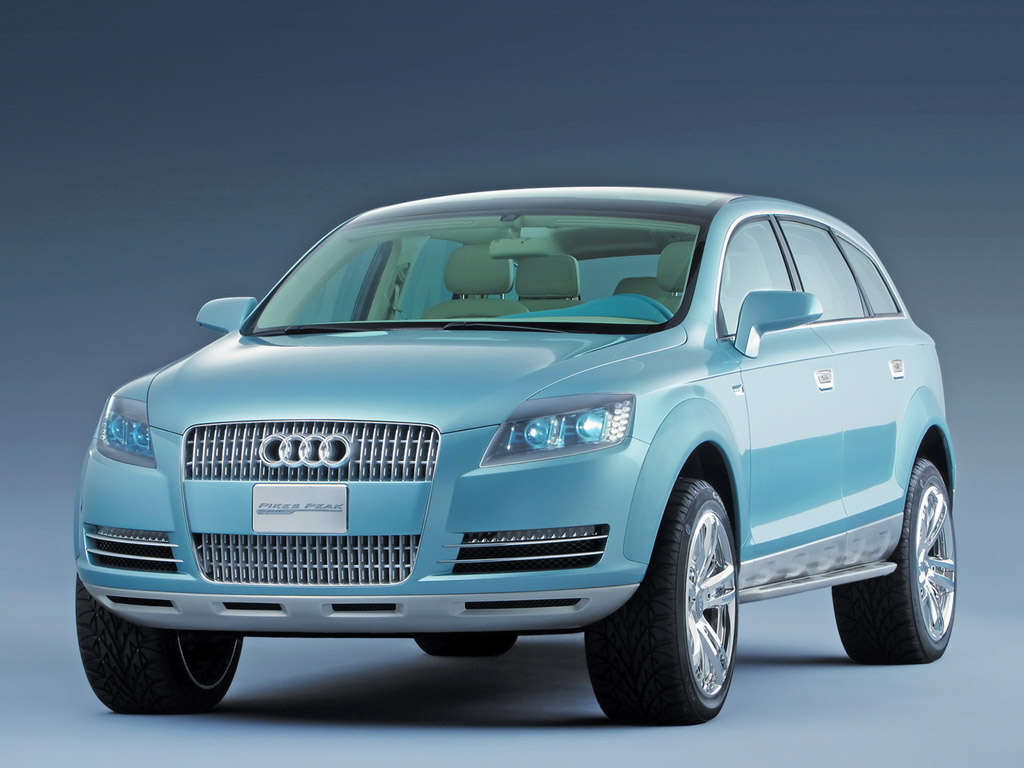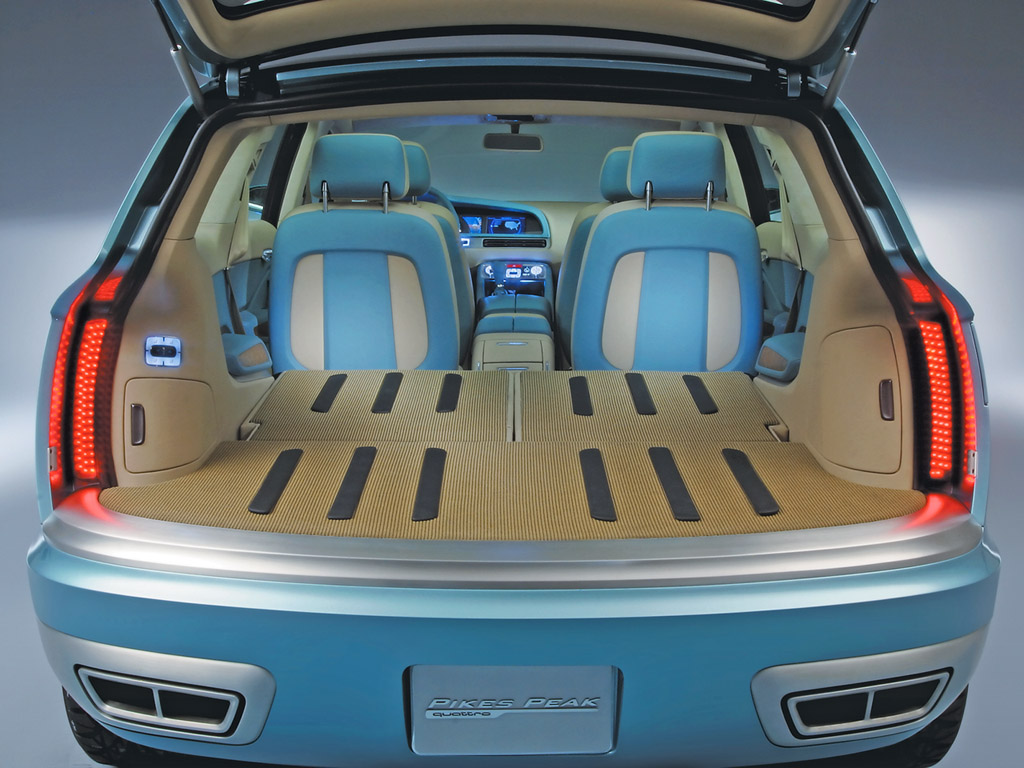2003 Audi Pikes Peak Quattro Concept
The idea behind the Audi Pikes Peak quattro
This four-door 4+2-seat hatchback is a
draft design that indicates the systematic evolutionary path that
current Audi design could take – but it is more besides:
the Pikes Peak quattro illustrates the novel AUDI AG concept that spans
several segments in the premium automobile category.
The Audi Pikes Peak quattro is notable for the manner in which it
combines the sheer power of the legendary Audi quattro and an advanced
design concept that brings together elements from widely varying types
of automobile.
The Audi Pikes Peak quattro is a crossover model. It possesses typical
qualities from a number of different automobile categories.
From the luxury sport sedan it adopts dynamism and comfort, but its
off-road competence comes from its variable-height adaptive air
suspension and quattro driveline. This is not all: the Audi Pikes Peak
quattro is equally convincing with its innovative seating concept with
variable elements as used in luxury vans.
What makes the Audi Pikes Peak quattro a truly forward-looking concept
are its restrained but elegant proportions, with a confident air of
supremacy and styling full of character that set it well apart from
clumsy attempts to interpret the theme of a ’go-anywhere' vehicle.
Design with character
The Audi Pikes Peak quattro is a typical
Audi interpretation of what form a striking, sporty crossover model with
strong premium affinities could take.
Generous curves, clearly defined outlines and muscular, taut surfaces of
large area are here united in an architecture in which tranquil beauty
and athletic tension create an intriguing contrast. The outer surfaces,
accented with swage-lines and interesting panel gap patterns, add
vitality to the styling.
To strengthen this impression, a bright “Polar Silver” metallic paint
finish has been chosen. Although the Audi Pikes Peak quattro conveys a
strong impression of strength and security, it cannot be said to lack
sporty elegance.
At the front, the Audi Pikes Peak quattro has a radiator grill divided
into two sections horizontally, with a boldly shaped surrounding frame.
Many of the visible details of the Audi Pikes Peak quattro are equally
striking. The Xenon Plus headlamps behind clear glass covers communicate
the technical aspect of their design, and supply a magnificent spread of
light for fast driving on the highway or to find a way along
loose-surfaced tracks after dark. The use of LEDs as a light source
permits the fog lamps to be extremely compact and permits boldly styled
rear lights to be used.
The loop-pattern door handles on the Audi Pikes Peak quattro only extend
when the advanced key function's proximity sensor has detected that an
authorized key holder wishes to enter the car. Door handle lights then
come on too. This remarkable approach to car access combines the visual
elegance of flush-mounted door handles with the substantial feel of
those with a loop for the driver or passenger to grasp.
The outside mirrors are also used to illuminate the area close to the
vehicle. A camera has been built into the mirror at the right, and
focused on the right front wheel. This ’dead area' is then displayed on
the MMI screen so that the driver can judge the clearance or the
distance from the edge of the road more effectively when crossing
difficult terrain.
Evidence of the dynamic properties of the Audi Pikes Peak quattro is
provided by the massive wheels with 5-arm double spokes (from the
outside, these have the appearance of two star-pattern wheels one behind
the other) and the tires with a specially developed tread pattern.
PAX wheels of size 295/770 R 560 A (equivalent to a visible wheel
diameter of 20.6 inches) help to keep the vehicle controllable if there
is a sudden loss of tire pressure. Their ’run-flat' construction means
that mobility is maintained if a tire failure should occur, and the
vehicle can be driven for up to 125 miles (200 kilometers) at speeds up
to 50 mph (80 km/h).
The interior: a new and welcoming ambience
The harmony of the overall concept
adopted for the interior creates strong links with the sporty, emotive
exterior styling. With fine materials and flawless workmanship, the
interior provides a new and most agreeable travel experience.
Matt-brushed aluminum and Japanese “Tamo” ashwood trim elements give it
sporty and technical, but also natural, welcoming accents. A glass roof
offers the occupants a panoramic view and a sense of space and light.
Dynamic but visually restrained, the fascia is framed and supported
visually by the doors.
The clear outlines featured in the driver's area are emphasized by a
raised center console that adds to the dignified, sporty impression
created by the entire interior. A novel type of display using 3D laser
optics makes the instruments brilliantly legible even when vision is
otherwise poor.
The multifunctional leather-covered sport steering wheel is of
three-spoke design, with tiptronic transmission shift paddles behind it.
The driver can select the chosen gear without having to take a hand off
the steering wheel.
For optimized occupant protection, two neatly housed additional “out of
position” cameras identify the front passenger's seated position and
modify triggering of the airbag appropriately.
The gear shift gate and the Audi-MMI unit (Multi Media Interface) are
located conveniently and ergonomically for the driver. By dividing up
the center console asymmetrically in this way, space is created on the
front passenger's side for a convenience package comprising two cup
holders and a shelf for small items. There is a cold-store compartment
under the split armrest.
All the centrally located controls have polished aluminum surrounds and
clear-glass covers to add visual impact to the interior.
The front center console is arranged like a bridge from the fascia to
the rear end of the front seats. Between the individual second-row seats
there is a second, retractable center console that emphasizes the
functional character of the Audi Pikes Peak quattro. It contains
controls for the infotainment electronics and another cold-store
compartment, shelf space and cup holders.
The caribou beige decor chosen for the interior harmonizes well with the
green color of various elements. The boldly contoured seats, for
example, are upholstered in high-quality caribou-color nappa leather,
the backs of the seat shells with Yukon green leather.
No compromises for the seats either
Six people can travel in the Audi Pikes
Peak quattro on three pairs of leather-upholstered seats. The decision
to adopt a 4 + 2 seating layout emphasizes the concept study's premium
character, with no cramped center seat accommodation above the prop
shaft tunnel, but instead a well-balanced blend of luxury and functional
efficiency.
All seats in the Audi Pikes Peak quattro have a wide range of electrical
adjustment. To simplify access to the rear seats, those in the second
row have an easy-entry function. If bulky loads have to be carried, the
two rear pairs of seats can be folded down so that their backs extend
the load area up to a capacity of 68 cu. ft (1,950 liters) when needed.
The rear seat is also folded electrically.
In the Audi Pikes Peak quattro the MMI display is not available only to
the front seat occupants. Two 6.8 x 5.1 inch (173 x 130 mm) screens fold
down from a console in the roof lining to provide both information and
entertainment for those sitting in the second and third rows. DVD and MD
drivers in the retractable center console, a separate MMI with Internet
access and USB and headphone plug connections are provided so that the
passengers have access to a varied selection of entertainment
facilities.
Reaching a strong conclusion: rear-end design
For easy loading, the tailgate of the
Audi Pikes Peak quattro extends into the rear side panels; it is opened
and closed electrically by remote control. Hand baggage can be placed in
the load area through the rear window, which opens separately.
The twin pairs of exhaust tailpipes integrated into the rear bumper add
visual harmony and deliver an agreeable, impressive sound.
Eight-cylinder, 500 hp engine with twin turbochargers and direct gasoline injection
Well known from the Audi RS 6, the V8
engine with twin turbochargers has been further developed and now has a
power output of 500 hp. A decisive factor in this power hike is the
advanced FSI direct gasoline injection principle, which indicated that
new standards were about to be set when it was used on the competition
cars that scored historic victories in the 2001 and 2002 Le Mans 24-Hour
races and in the American Le Mans Series. Powerful FSI engines are
already in production for the Audi A2 and A4 models.
In the Audi Pikes Peak quattro the eight-cylinder twin-turbo FSI engine
is notable for its free revving and vigorous pulling power at all engine
speeds. It accelerates the Audi Pikes Peak quattro from 0 to 100 km/h in
only 5.0 seconds (0 – 60 mph in 4.7 sec) and takes it on to a governed
top speed of 155 mph (250 km/h). Its maximum torque of 630 Newton-meters
is available from as low an engine speed as 2000 rpm upwards and remains
constant over a broad speed range. This supreme, massive pulling power
is ideal for fast cross-country driving and for negotiating off-road
sections of the journey.
Ultimate progress on all roads
It was only logical for Audi, when
drafting out this versatile concept vehicle, to include all its in-depth
quattro driveline know-how and its experience with variable-height
active air suspension. The development engineers' brief was for the Audi
Pikes Peak quattro to be able to tackle loose surfaces and poor roads
just as supremely as fast sections of the highway.
In all driving situations and across all kinds of surface, quattro
permanent all-wheel drive stands for optimum traction and dynamic
stability.
The standard torque split between the axles is 50% to the front and 50%
to the rear, but if wheelspin occurs at either axle the split is
diverted to the axle with more grip.
The electronic differential lock (EDL) controls torque distribution
between the two wheels on an axle. Then there is the Electronic
Stabilization Program (ESP), which assists the driver when potentially
critical driving situations close to the handling limit have to be
mastered. Like all Audi quattro cars, the Pikes Peak quattro provides
the best possible traction on all surfaces and in all conditions.
Variable-height pneumatic control at both axles responds automatically
when the load carried by the vehicle increases, and restores its ride
height to the standard level. The air springs support the entire load at
each axle.
A highlight of innovative safety: the lane departure warning system
The lane departure warning system is a
special function that actively supports the driver. By means of an
optical sensor, this driver assistance system scans the road markings
and issues an acoustic warning signal and a physical response in the
form of steering wheel vibration if the driver departs from his or her
chosen lane.
A warning that an unintentional lane change is taking place is then
given to the driver as a means of avoiding a possible accident. Also
installed on the Audi Pikes Peak quattro: adaptive cruise control, which
not only performs the functions of a conventional cruise control system
but also maintains the desired distance from the vehicle in front
automatically.
Adaptive air suspension
A special feature of the Audi Pikes Peak
quattro is its variable-height adaptive air suspension. This Audi system
makes the Pikes Peak quattro into a most impressive all-rounder. Ample
ground clearance – up to 11 inches
(280 millimeters) for crossing rough terrain – can be preselected at the
MMI; at high speeds, the body can be lowered so that its center of
gravity is lower and its aerodynamics are optimized.
As road speed increases, the suspension is lowered and the shock
absorber settings varied automatically, so that optimum dynamic
stability is assured.
Audi is systematically exploring new paths



